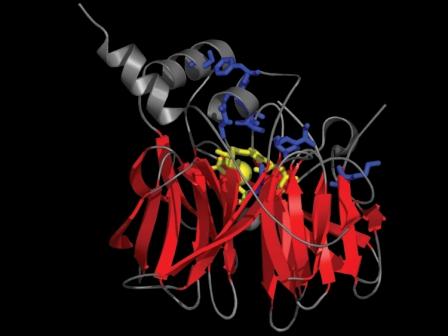Researchers may have found a way to protect us against otherwise deadly chemical attacks, such as the subway sarin incident in Tokyo that left thirteen people dead and thousands more injured or with temporary vision problems. The method is based on a new and improved version of a detoxifying enzyme produced naturally by our livers, according to the report in the April 2012 issue of Chemistry & Biology, a Cell Press publication.
“The sarin attack in Tokyo in 1995 demonstrated that both the raw materials and know-how of producing deadly nerve agents are available to people outside government or military institutions,” said Moshe Goldsmith of the Weizmann Institute of Science in Israel. “We hope that our work would provide a prophylactic drug that will effectively protect the medical, police, and other teams that will have to act in a contaminated area following such an attack and would also provide these teams with a drug that could be administered on-site to intoxicated individuals to greatly improve their chances of survival.”
Today, protection against nerve agents relies primarily on physical barriers such as gas masks and protective suits that can easily be breached, Goldsmith explained. Following exposure, people are treated with drugs that help with the symptoms but don’t eliminate the nerve agent.
Goldsmith and the study’s senior author Dan Tawfik hope to change this, relying on the principles of evolution to produce a more efficient version of an enzyme that occurs naturally in all of us. Known as paraoxonase 1 (PON1), this enzyme was originally named for its ability to assist in the breakdown of the insecticide paraoxon. It is also involved in drug metabolism and detoxification.
PON1 normally does counteract G-type nerve agents, including sarin, tabun, soman, and cyclosarin, but not well enough. Tawfik’s lab specializes in a technique called “directed enzyme evolution,” in which they artificially introduce mutations into the gene encoding a target enzyme, in this case PON1. The mutated versions of the gene are then put back into bacteria, which produce the enzymes for testing.
The goal was to end up with enzymes capable of detoxifying G-type nerve agents before those nerve agents could reach their target and cause harm. Those that passed the initial test went on to further rounds of evolution and testing.
After four rounds of evolution, the researchers obtained PON1 variants that worked up to 340 times better than those produced previously. Overall, the researchers reported that the PON1 variants showed 40- to 3,400-fold higher efficiency than the normal enzyme in metabolizing the three most toxic G-type nerve agents.
These new and improved PON1 enzymes have become promising candidates for use as preventive and postexposure treatments in the event of a terrorist attack.
“We hope that our enzymes would be able to act together with currently available drugs to improve survival rates following intoxication,” Goldsmith said. More broadly, the findings show the power of laboratory evolution to completely reshape existing enzymes for a variety of uses.
Goldsmith et al.: “Evolved stereoselective hydrolases for broad-spectrum G-type nerve agent detoxification.”

PON1 molecular structure. From the lab of Prof. Dan Tawfik
Prof. Dan Tawfik’s research is supported by the estate of Mark Scher; Ms. Miel de Botton, UK; and the Sassoon and Marjorie Peress Philanthropic Fund. Prof. Tawfik is the incumbent of the Nella and Leon Benoziyo Professorial Chair.
Click here for article.
